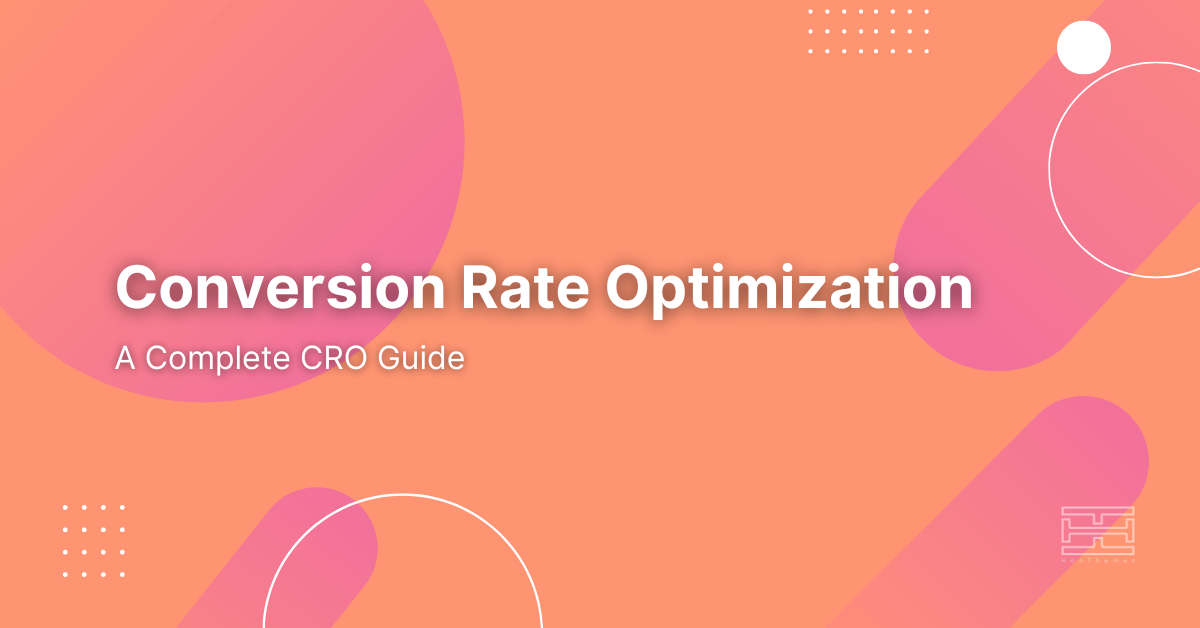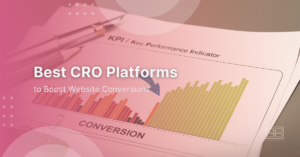Conversion rate is one of the most important website performance metrics that indicate how successful your marketing efforts are. It shows if people are interested in your offer and take the desired action on your website. Usually, a higher conversion rate means your marketing strategies have been effective. Even more important is knowing the appropriate methods for better conversion rate optimization.
However, with the stiff competition in the market, converting your website visitors might not always be easy. Therefore we’ll discuss all you need to know about CRO and help you learn website conversion optimization in this easy-to-digest guide.
What Is Conversion Rate?
Conversion rate is the percentage of website visitors who take the desired action and convert. This desired action refers to any action you want visitors to take, including making a purchase, completing a form, or signing up.
You can have multiple conversion goals, and you should calculate the conversion rate separately.
How Do You Calculate the Conversion Rate?
You can calculate your conversion rate with a simple formula. You only have to divide your total number of conversions by the total number of visitors in a specific time frame and multiply it by 100. To calculate the conversion rate, use the below formula:
For example, if you had 2000 visitors last month and 500 of them converted, your conversion rate is 25 percent.
Conversion Rate = ( 500 / 2000 ) * 100 = 25%
CRO Meaning Explained: What Is Conversion Rate Optimization?
Conversion rate optimization (CRO) increases the number of a website’s conversions by optimizing it. The process involves monitoring website visitors to obtain a deep understanding of their behavior. This understanding enables marketers to discover what encourages the target audience to take action and convert.
By focusing on conversion rate optimization, you will motivate more and more of your visitors to take the desired action.
Why Is Conversion Rate Optimization Important?
Conversion rate optimization is essential as it allows you to improve the performance of your website or app. Knowing how many of your users convert and how your business grows enables you to identify improvement opportunities.
The important thing about CRO marketing is that you will boost your revenue without increasing your website traffic. You can reduce the costs of generating traffic and spend your resources on increasing the conversion rate.
How to Create a Conversion Rate Optimization Plan in 5 Steps
Successful conversion rate optimization requires developing a comprehensive plan. Therefore, we will discuss how to create one to get started with the optimization process.
First, it’s necessary to identify the areas of your website that need to be optimized. Next, you should constantly watch these areas and optimize them to ensure they work fine. Remember, without detecting the leaks in your conversion funnel, all your efforts might go to waste.
Now, let’s see what the steps to creating a conversion rate optimization plan are:
1: Understand Your Ideal Customer
Knowing your customers is crucial to understanding how to start the process. If you don’t take the time to understand your audience, you won’t get results. So, research your target market and try to create buyer personas based on the data you’ve collected.
Buyer personas will give you a clear picture of who your ideal customers are. They will help your marketing team understand customers’ behavior and buying habits. Then, they can focus on creating content that will encourage prospects to buy your products or services.
One of the best ways to understand your customers is using a behavior analytics tool such as WatchThemLive. This all-in-one CRO tool, and on a broader scale, a CRO platform, offers services like heatmaps and session replays that enable you to track visitors’ interactions on your website.
The heatmaps provide you with a visual representation of visitors’ clicking activity. You can analyze them to determine how effective your call to action is and if people are paying attention to important elements.
With session replays, you can watch recorded videos of visitors’ on-screen activities on your website. Watching these videos is an excellent way to detect user experience problems and what prevents visitors from converting.
Why not try it when all the features are free to use? You can create an account on Watch Them Live and start free today.
2: Identify and Prioritize the Conversion Goals
After you’ve created your buyer personas, you need to identify your website’s conversion goals. Your website can have more than one goal. For example, the conversion goals of an eCommerce website can include:
- Completing online orders
- Capturing email addresses of website visitors
- Increasing new product awareness
- Allowing customers to create wishlists
Now that you have identified all your goals, you should prioritize them according to the value of the conversions. To prioritize the goals, you need to consider the right metrics and the value each adds to your business. Determining the value of the conversion goals helps you realize how much effort and time you need to dedicate to each.
3: Identify the Conversion Paths
The next step is determining what journeys customers take to complete a conversion goal. It would be best to track your website visitors’ navigation paths and the web pages they visit before they convert.
Let’s take a look at a conversion path on Amazon where a visitor completes a purchase:
The visitor starts the journey by viewing a product category.
Then, they choose a product to see the details.
If the visitor decides to buy the item, they will add it to their shopping cart.
Finally, the visitor proceeds to check out to complete the order and convert.
4: Detect and Fix the Conversion Problems
Now that you know your website’s conversion goals and the paths that lead, it’s much easier to identify the problems. Each of your web pages supports at least one conversion goal. Usually, it would be better if each page focuses on the main conversion goal rather than multiple ones. This way, visitors are more likely to complete the goal as they won’t get confused by different CTAs.
Analyze your pages and figure out how you can optimize each of them to increase their conversion rate.
5: Keep Evaluating Your Website
Conversion rate optimization is a continuous process, and it doesn’t end once you’ve optimized your website. As visitor behavior is constantly changing, you should change and improve your marketing strategy as well. Make sure to track your website analytics and visitors’ behavior to keep up with their evolving needs and expectations.
5 Conversion Rate Optimization Best Practices
Now, let’s see what some of the best conversion rate optimization strategies are:
Conversion Rate Optimization Best Practice #1: Develop a Hypothesis and Test
Forming a hypothesis is necessary to understand what you need to test and optimize. The hypothesis allows you to define the problem and suggest solutions that you think might work.
Here’s an example of a hypothesis:
“By changing the color of the CTA button from yellow to red on the landing page, the click-through rate will increase as it will attract more attention.”
As you can see, this way, you will know exactly what you are testing and what you want to achieve.
Conversion Rate Optimization Best Practice #2: Create Dedicated Landing Pages
Directing your website traffic to a dedicated landing page for your marketing campaigns will increase conversions significantly. This stand-alone web page is designed with the main purpose of converting website visitors.
Landing pages are crucial if you are running a paid advertising campaign. By sending people who click on your ad to an optimized landing page, you can prevent your traffic from going to waste.
So, instead of sending traffic to your homepage, create a high-converting landing page where you can focus your CRO efforts.
Conversion Rate Optimization Best Practice #3: Perform A/B Testing
A/B testing is one of the most effective methods for optimizing websites and increasing conversion rates. This method involves creating two variants of the page you want to test and splitting the traffic between them. This way, you can find out which variant has a higher conversion rate and why.
You can start by testing your higher-traffic pages where there are more conversion opportunities. Another good place to start is the pages with the lowest conversion rates. You might be able to see a considerable improvement with a single A/B test on these pages.
Conversion Rate Optimization Best Practice #4: Improve the Quality of Your Website Traffic
You might have good website traffic; however, it won’t matter if you can’t convert them into customers. That’s why you must ensure you’re attracting relevant traffic to your website. Even if you have a perfect website with poor-quality traffic, you won’t get any results.
Identify your high-quality traffic sources so you can invest more in them. Also, it might be a good idea to stop spending money on sources with low conversion rates.
Additionally, research your audience and make sure your ads are relevant to the needs and interests of your target market.
Conversion Rate Optimization Best Practice #5: Track Micro-Conversions
Micro-conversions are small steps website visitors complete to reach the main conversion goal. Here are some examples of micro-conversions:
- Sharing content on social media
- Commenting on a blog post
- Adding products to the shopping cart
- Viewing a specific web page
Although micro-conversions don’t result in new customers, monitoring them will give you invaluable insights into optimizing your conversion rate. Tracking these small actions is an excellent way to identify conversion funnel leaks and understand how to fix them.
For example, imagine many website visitors are not filling out your contact form. This might mean the form is too long or you are asking for information that seems unnecessary.
Wrapping Up Our Conversion Rate Optimization Guide
Conversion rate is a key marketing metric that helps you measure the effectiveness of your campaigns. To increase your conversion rate, you must understand your target market deeper. We hope you have a better understanding of the concept behind conversation rates and learned how conversion rate optimization is done right.
Stay updated with more informative content:


![Read more about the article 50 Best Behavioral Analytics Tools in 2023 [Definitive List]](https://www.hoothemes.com/wp-content/uploads/2022/10/50-Best-Behavioral-Analytics-Tools-in-2022-Definitive-List-300x157.png)






